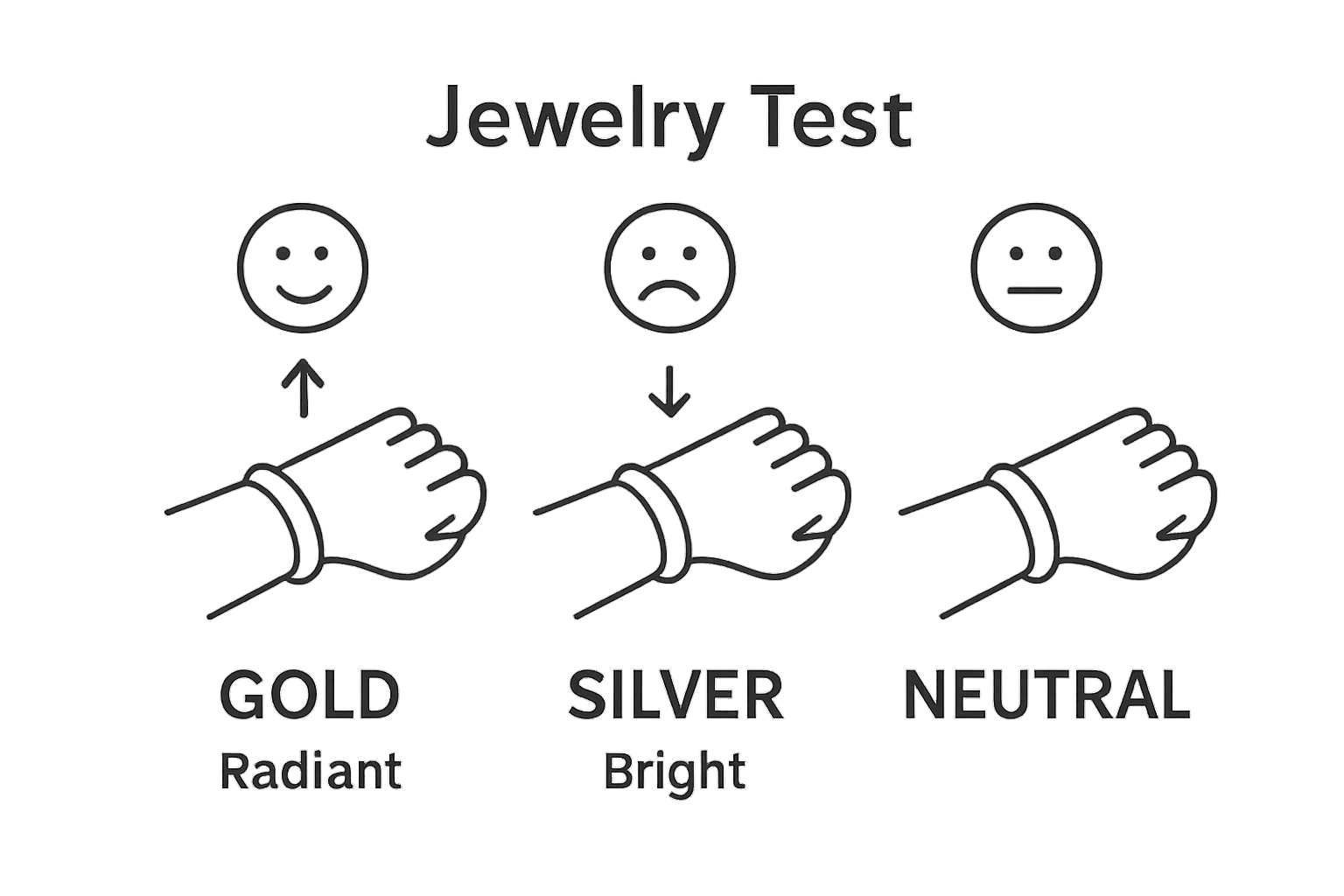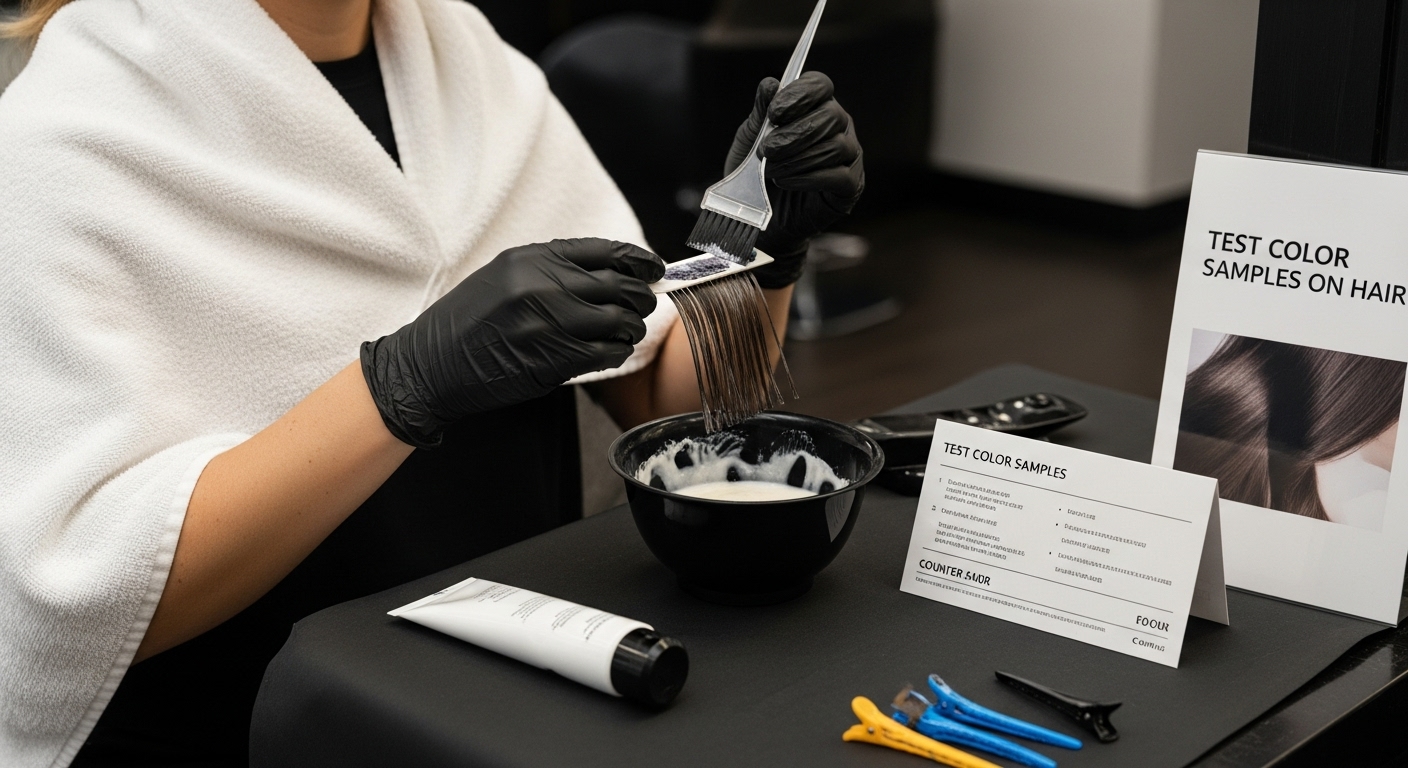Picking a new hair color can feel risky, but it is more than just a style upgrade. Did you know professional consultations can prevent up to 80 percent of avoidable color mistakes according to research? You might guess it’s all about the hottest trends and personal taste, yet the right choice is actually rooted in things as simple as your wrist and your jewelry box. That detail flips the script and makes your next hair color a science as much as an art.
Table of Contents
- Step 1: Identify Your Skin Undertone
- Step 2: Define Your Personal Style Goals
- Step 3: Explore Hair Color Options
- Step 4: Test Color Samples on Hair
- Step 5: Consult With A Professional Stylist
- Step 6: Make Your Final Decision
Quick Summary
| Key Point | Explanation |
|---|---|
| 1. Identify your skin undertone | Understanding your skin’s undertone helps you choose hair colors that enhance your appearance and complexion. |
| 2. Define personal style goals | Reflect on your motivations for changing hair color to ensure it aligns with your identity and lifestyle. |
| 3. Explore color options carefully | Use temporary and semi-permanent dyes to experiment with colors before committing to a permanent change. |
| 4. Conduct strand tests for accuracy | Test color samples on a small hair section to see how they interact with your hair type and existing color. |
| 5. Consult a professional stylist | A consultation with an expert guides you through color possibilities and guarantees healthier hair transformations. |
Step 1: Identify Your Skin Undertone
Choosing the perfect hair color starts with understanding your unique skin undertone—a critical foundation that determines which colors will naturally enhance your appearance. Your skin’s underlying hue plays a pivotal role in selecting a hair color that will make you look radiant and harmonious.
To determine your skin undertone, you’ll need natural lighting and a few strategic observation techniques. Begin by examining the skin on your inner wrist or along your jawline, where undertones reveal themselves most clearly. Warm undertones typically present with golden, peachy, or yellow hues, while cool undertones showcase hints of pink, blue, or violet.
Perform a simple jewelry test to confirm your undertone. Hold both gold and silver jewelry next to your skin. If gold jewelry makes your skin look more vibrant and complements your natural coloration, you likely have warm undertones. Conversely, if silver jewelry creates a more flattering effect and seems to brighten your complexion, cool undertones are probable.
 For those with neutral undertones, both metals will appear equally appealing.
For those with neutral undertones, both metals will appear equally appealing.
According to research from New Mexico State University, analyzing your skin without makeup under natural or incandescent lighting provides the most accurate assessment. Consider using a white towel around your shoulders to eliminate external color interference and focus solely on your skin’s natural undertones.
If you find yourself uncertain about your undertone, professional stylists can provide a precise assessment.
Some individuals have olive or neutral undertones, which can make identification more nuanced. In such cases, consulting with a hair color specialist can help you make the most informed decision about your ideal hair color transformation.
Step 2: Define Your Personal Style Goals
Selecting the right hair color transcends mere aesthetic preferences—it’s a profound expression of personal identity and emotional transformation. Your style goals serve as a strategic roadmap, guiding you toward a hair color that not only looks stunning but also resonates deeply with your inner self.
Begin by engaging in thoughtful self-reflection about your motivations. Are you seeking a subtle enhancement that amplifies your natural beauty, or do you crave a bold, dramatic statement that announces a significant life transition? Professional stylists recommend examining your lifestyle, personality, and emotional aspirations when contemplating a hair color change.
Consider the practical dimensions of your desired transformation. Professional environments might require more conservative color choices, while creative fields often welcome more adventurous expressions. If you work in a corporate setting, you might opt for rich, sophisticated tones that maintain a polished appearance. Conversely, those in artistic industries might explore vibrant, unconventional shades that showcase personality and creativity.
According to psychological research published in Psychology of Women Quarterly, individuals who set clear, intrinsic goals for appearance changes experience greater personal satisfaction. This means your hair color should ultimately reflect an authentic vision of yourself, not merely mimicking external trends or expectations.
Carefully assess your comfort level with maintenance and potential color transitions. Some hair colors require more frequent touch-ups or specialized care, which demands both time and financial investment. Realistic goal-setting is crucial—choose a color that aligns not just with your aesthetic preferences, but also with your willingness to invest in ongoing hair care and professional maintenance.
Ultimately, your hair color is a powerful form of self-expression. By thoughtfully defining your style goals, you transform a simple color change into a meaningful personal journey of reinvention and confidence.
Step 3: Explore Hair Color Options
Navigating the expansive world of hair color requires a strategic and informed approach. This step transforms your vision into a tangible palette of possibilities, bridging the gap between your personal style goals and potential color transformations.
Temporary and semi-permanent colors offer an excellent starting point for those hesitant about committing to a dramatic change. These options provide a low-risk opportunity to experiment with different shades, allowing you to test how various colors complement your skin tone and personal aesthetic. Temporary dyes typically wash out within a few shampoos, making them ideal for those wanting to sample new looks without long-term commitment.
For more dramatic and lasting transformations, permanent hair colors provide rich, enduring results.
Below is a comparison table explaining the main types of hair color options mentioned in the article, helping you understand their characteristics and commitment level.
| Color Type | Duration | Commitment Level | Key Features |
|---|---|---|---|
| Temporary | A few shampoos | Low | Ideal for short-term changes, easily washes out |
| Semi-permanent | Several weeks | Medium | Fades gradually, minimal damage |
| Permanent | Months (until grown out) | High | Long-lasting, penetrates hair shaft, vibrant color |
| These formulations penetrate the hair shaft, delivering intense color that remains vibrant for several weeks to months. When selecting a permanent color, consider not just the initial shade but how it will fade and evolve over time. Some colors maintain their brilliance longer, while others may require more frequent touch-ups to preserve their original intensity. |
According to the National Cancer Institute, understanding the chemical composition of hair dyes is crucial for making informed decisions. Different types of dyes interact with your hair differently, impacting both color longevity and hair health.
Visual research becomes an invaluable tool in this exploration. Utilize digital hair color apps that allow you to virtually test different shades, or collect inspiration from professional hair stylists’ portfolios. Many salons offer consultations where expert colorists can provide personalized recommendations based on your unique hair texture, current color, and desired outcome.
Remember that professional guidance can dramatically improve your color selection process. A skilled colorist can help you navigate potential challenges like color correction, managing existing hair damage, or achieving complex color techniques like balayage or ombré. They bring technical expertise that transforms a simple color change into a nuanced, artful transformation tailored specifically to your individual characteristics.
Step 4: Test Color Samples on Hair
Testing color samples is a critical checkpoint in your hair color transformation journey, offering a crucial opportunity to preview potential outcomes before making a full commitment. This step allows you to visualize how different shades interact with your unique hair texture, existing color, and skin undertones.
Strand testing is your most reliable method for previewing potential hair color results. Select a small, inconspicuous section of hair—typically from the underlayer near the nape of your neck—to apply your chosen color. This strategic approach minimizes visible damage or unexpected color outcomes while providing an accurate representation of how the dye will process on your specific hair.
Prepare your test strand carefully by ensuring it is clean, dry, and free from styling products. Use a professional applicator brush or cotton swab to apply the color mixture precisely, following the manufacturer’s instructions with meticulous attention to detail. Natural lighting is essential for accurate color assessment, so evaluate your test strand near a window or in well-lit spaces that reveal true color nuances.
According to forensic research analyzing dyed hair samples, hair dye interactions can produce surprisingly complex results. Some colors may appear differently after initial application, with subtle changes occurring during the first few wash cycles.
Pay close attention to processing time and potential chemical interactions. If you have previously colored or chemically treated hair, your test strand might react differently than virgin hair. Professional stylists recommend conducting a patch test at least 48 hours before full application to check for potential allergic reactions and to observe how the color develops over time.
Document your test results by taking clear, well-lit photographs from multiple angles.
 These visual records will help you compare different color samples, track color progression, and make informed decisions about your final hair color transformation. Remember that patience and careful observation are key to achieving your desired aesthetic outcome.
These visual records will help you compare different color samples, track color progression, and make informed decisions about your final hair color transformation. Remember that patience and careful observation are key to achieving your desired aesthetic outcome.
Step 5: Consult with a Professional Stylist
A professional hair consultation transforms your color transformation from a potential risk into a precisely crafted artistic experience. This pivotal step bridges your personal vision with expert technical knowledge, ensuring that your desired hair color not only looks stunning but remains healthy and vibrant.
Preparation is key when meeting with a professional stylist. Arrive with visual references—screenshots, magazine clippings, or digital images that capture the exact shade and style you envision. These visual aids help communicate your goals more effectively than verbal descriptions alone. Bring documentation of your previous hair treatments, including any chemical processes, to provide your stylist with a comprehensive understanding of your hair’s history and current condition.
During the consultation, expect a thorough professional assessment of your hair’s health, texture, and color compatibility. Skilled stylists conduct comprehensive evaluations, examining factors like hair porosity, existing color undertones, and potential chemical sensitivities. They will discuss realistic expectations, potential challenges, and recommend techniques that align with your hair’s unique characteristics.
According to hair consultation research, these professional sessions are crucial for preventing unnecessary damage and ensuring client satisfaction. Your stylist will develop a personalized strategy that considers not just the immediate color transformation, but also long-term hair health and maintenance requirements.
Be prepared to discuss your lifestyle, maintenance commitment, and budget. Professional colorists can recommend color techniques that match your daily routine, whether you prefer low-maintenance looks or are willing to invest time in more intricate color upkeep. They might suggest alternatives like balayage or subtle highlights that provide visual interest while minimizing frequent touch-up requirements.
The consultation concludes with a detailed treatment plan, including estimated time, potential costs, and recommended post-color care products. This transparent approach ensures you feel confident and informed about your upcoming hair color transformation, turning what could be an uncertain process into an exciting, collaborative journey of personal reinvention.
Step 6: Make Your Final Decision
Making your final hair color decision represents the culmination of a thoughtful, strategic journey of self-discovery and aesthetic exploration.
Here is a step overview table summarizing the key actions, what they accomplish, and any special notes for each stage of the hair color selection process outlined in this guide.
| Step | Purpose | Special Notes |
|---|---|---|
| 1. Identify Skin Undertone | Find shades that enhance your complexion | Use jewelry test or consult a stylist |
| 2. Define Personal Style Goals | Ensure color matches your identity & needs | Reflect on motives and lifestyle |
| 3. Explore Hair Color Options | Discover suitable shades and products | Start with temporary/semi-permanent dyes |
| 4. Test Color Samples | Preview results safely | Do strand tests in natural lighting |
| 5. Consult with Professional Stylist | Receive personalized expert advice | Bring hair history and inspiration photos |
| 6. Make Your Final Decision | Select and commit to your new look | Balance desires with maintenance factors |
| This pivotal moment transforms all your previous research, consultations, and color testing into a tangible personal transformation. |
Trust your initial instincts while remaining open to professional guidance. Your strand tests, consultation insights, and personal style goals should collectively inform your choice. Consider not just the immediate visual impact, but how the color will integrate with your lifestyle, professional environment, and personal maintenance capabilities.
Reflect deeply on the emotional significance of your color choice. Hair color is more than a cosmetic change—it’s a powerful form of self-expression that can boost confidence and reflect inner personal transitions. Some individuals choose colors that symbolize personal growth, while others seek colors that feel authentically aligned with their sense of identity.
According to research in the Journal of Cutaneous and Aesthetic Surgery, informed decision-making involves evaluating personal preferences alongside practical considerations. This means balancing your aesthetic vision with realistic expectations about color maintenance, potential hair health impacts, and long-term styling versatility.
Financial and time investment are crucial factors in your final decision. Professional color treatments can be significant investments, so ensure your chosen color aligns with your budget for both initial application and subsequent maintenance. Some colors require more frequent touch-ups or specialized hair care products, which can impact your ongoing styling expenses.
Before making your final commitment, visualize yourself with the new hair color in various contexts—professional settings, social environments, and personal moments. Imagine how the color makes you feel, not just how it looks. A truly successful hair color transformation transcends mere aesthetics, becoming a reflection of your inner confidence and personal style narrative.
Ready for a Hair Color Transformation That Truly Reflects You?
You have spent time learning about skin undertones, defining personal style goals, and understanding the importance of professional consultations. But making that final decision can still feel overwhelming. Maybe you are worried your chosen color will not complement your features or that the result will not last. You deserve expert guidance and a stylist who brings your vision to life in a way that is both stunning and uniquely yours.

Discover how the seasoned team at Joel C Ma Hair Studio can turn your color journey into a work of art. With more than 25 years of experience and a commitment to advanced color techniques like balayage and personalized style consultations, we promise a seamless transformation that is tailored to you. Do not leave your next chapter to chance. Book your consultation now and experience the confidence of truly customized hair color.
Frequently Asked Questions
How can I determine my skin undertone for choosing a hair color?
To determine your skin undertone, check the skin on your inner wrist or jawline in natural light. Look for golden or peachy hues for warm undertones, and pink or blue hints for cool undertones. A jewelry test with gold and silver can also help confirm your undertone.
What are the differences between temporary, semi-permanent, and permanent hair colors?
Temporary colors wash out after a few shampoos and are low-risk for experimentation. Semi-permanent colors last longer but will fade gradually. Permanent colors penetrate the hair shaft for long-lasting results, requiring consideration of how the color will fade over time and maintenance.
Why is strand testing important before coloring my hair?
Strand testing allows you to preview how a color interacts with your hair texture and current color. It helps ensure the chosen shade will suit you, minimizing unexpected results and allowing you to observe how the color develops.
What should I expect during a professional hair consultation?
During a professional consultation, expect an evaluation of your hair’s health, texture, and color compatibility. The stylist will discuss your goals, realistic expectations, and techniques suited for your hair while recommending personalized strategies for your desired transformation.





